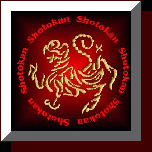Dark side of the moon
esotherysm and martial arts
KUJIKIRI
Copyright © 2002 James Deacon
KUJI-IN
It is from the Mikkyo traditions that the healing art of Tenchi Seiki Te-Ate has received its more esoteric or mystical disciplines, including practices involving the use of shingon / jumon (mantras), nenriki (visualisation of symbols, mandalas, etc) and in-zou / ketsu-in (mudras - mystical 'finger-weavings' - special ritual gestures formed by knotting the fingers is various complex patterns)
The triple-discipline of shingon, nenriki and in-zou is generally referred to as: sammitsu [or: san-himitsu] meaning: "The Three Secrets" or "The Three Mysteries", and it is through the study and practice of this discipline that adherents of 'mainstream' Japanese Mikkyo Buddhism seek to awaken direct experience of Enlightenment.
However, in the hands of more 'avant-garde', shamanic-like, ascetic practitioners of Mikkyo - various groups such as the Senin, Gyoja, and Shugenja / Yamabushi mountain ascetics - sammitsu evolved into a synergistic discipline of wideranging and profound practical and mystical application.
The discipline became not just a path to enlightenment, but also a means of developing, focussing and empowering 'special' abilities - from enhanced physical co-ordination, to control of pain, to powers of exorcism and healing, to increased intuitive and psychic sensitivity, to the induction of shamanic-like visionary states.
Possibly the most famous outgrowth of sammitsu is the kuji-in [or:kuji-no-in], also referred to as kuji goshin ho: "spiritual protection by the nine syllables of power", and sometimes as ju jutsu, or jujitsu (no relation to the martial art of that name - except in the meaning of the words: soft techniques).
The kuji-in is a method of focusing the mind, the will & the subtle energies to specific intent, and a means of temporarily 'powering-up' the practitioner's 'psychic' senses.
In its complete form, the kuji-in involves the fukushu (recitation or repitition) of the sacred nine-word shingon: "Rin-Pyo-To-Sha-Kai-Jin-Retsu-Zai-Zen" (Lin-Byou-Dou-Sha-Kai-Jin-Lets'-Zai-Zen) combined with the performance of nine accompanying in-zou, and relevant nenriki visualisation; however, each of the nine component 'segments' of kuji-in has its own specific attributes and function and acts as a triggering mechanism for a very specific given intention.
When practiced with the proper breathing patterns and in the proper meditative state, the kuji-in is considered a very potent technique & has traditionally been used by mystics, warriors, priests, healers and shamanic practitioners alike; in fact it is at the very core of Japanese Mystical, Magical, and Shamanic practice.
While there are said to be in total 81 different ways of intertwining the fingers, the use of kuji-in within the art of Tenchi Seiki Te-Ate (as is the case with most other practitioners of this focussing technique) is generally limited to the core sequence of nine signs mentioned above, formed in smooth-flowing succession - the number nine being considered a highly potent number in Japanese mystical thought. There are however a further five ketsu-in used in Tenchi Seiki Te-Ate (as distinct from the formal kuji-in sequence) - each of which, along with specific name, attribute, shingon, and imagery, has a special shuji or 'seed' character which enhances the vibratory power of the particular finger sign.
In Tenchi Seiki Te-Ate the kuji-in is used primarily in developmental meditative and energy-strengthening & grounding practices.
It is held that certain of the body's energy channels come to highly sensitive points of focus or tsubo in both the hands and feet; and on one level, the use of the various ketsu-in provides a means of at least temporarily recalibrating and directing seiki by manipulating these tsubo through a combination of pressure, breathing, and the gesture/sound/imagery triggering mechanism as mentioned above.
KUJI KIRI
Inextricably linked with the kuji-in is the technique of kuji-kiri ('the cutting of the nine signs/lines' - kiri meaning to cut) - and the two techniques are frequently confused by the less well -informed
Whereas the kuji-in employs the fingers to focus, the kuji-kiri method employs a grid of nine lines: five horizontal and four vertical - each representing one of the 9 finger signs and their attributes.
In the art of Tenchi Seiki Te-Ate, this cross-hatched symbol is used as a means of focussing therapeutic influence. It is drawn (in the air, on the hand, or on a specific area of the body) with a special 'energy-gesturing' hand-form, known as the 'sword fingers' and is sometimes preceded by the performance of either the formal kuji-in or one of the other aditional ketsu-in mentioned in a previous section.
For the kuji-kiri to be effective the lines must be drawn in the correct order, with the proper focus of seiki, for the 'intent' to work, and to complete or seal the specific healing intent of the energy focus a practice known as the 'placing of the tenth character' is used. This involves drawing one of a series of special symbols or characters onto the centre of the now empowered grid.
In the past, though it is a less common practice in modern Tenchi Seiki Te-Ate the kuji-kiri would be drawn in red ink on special slowburning paper which was then folded into a fan and lit - the fumes being wafted over the patient - particularily around the area of any specific ailment (much akin to the practice of 'smudging'.).

